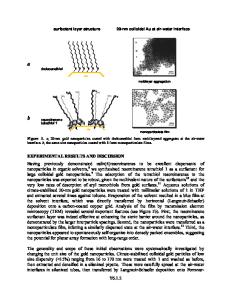Self-Assembly of Iron Nanoparticle Arrays
- PDF / 1,623,084 Bytes
- 12 Pages / 612 x 792 pts (letter) Page_size
- 90 Downloads / 310 Views
MM1.4.1
Self-Assembly of Iron Nanoparticle Arrays S. A. Majetich and D. F. Farrell Dept. of Physics, Carnegie Mellon University Pittsburgh, PA 15213, U.S.A.
ABSTRACT Surfactant-coated spherical iron-based nanoparticles 3.0-9.5 nm in diameter were synthesized and dispersed in hexane. TEM images of dried particle assemblies were taken and analyzed to discover the structure of the assemblies, and to establish the relationship between particle concentration, surfactant type, and conditions of drying and array structure.
INTRODUCTION The first particles found to self-assemble into arrays were colloidal crystals of silica or latex spheres in aqueous solutions. There self-assembly is driven by repulsive interactions between the electric double layers surrounding the particles [1,2]. However, there is very little free charge in an alkane solvent, such as the hexane used to prepare the iron nanoparticle arrays described here, and therefore other forces dominate. For uniformly magnetized spherical particles, the field produced by the particle is equivalent to the field produced by a point dipole with the moment of the particle. With magnetic interactions alone or dominant, particles will form chains in their lowest energy configuration. To prevent agglomeration, magnetic particles must be sterically stabilized with surfactants. To prevent chain formation, large polymer surfactants can be used, in order to reduce the magnitude of the magnetic forces. Alternatively higher temperatures can be used so that thermal fluctuations rapidly change the magnetization direction in the particles, and their time-averaged magnetic interactions are nearly zero. Such particles are said to be superparamagnetic [3]. In a dispersion of superparamagnetic particles, thermal fluctuation of the particle moments occurs on a scale of ~109 Hz. This is orders of magnitude faster than reorientation due to Brownian motion, which occurs on a scale of ~106 Hz. With such fast transition to equilibrium, it is generally assumed that magnetic interactions between superparamagnetic particles above the blocking temperature are negligible, and the particles may be treated as non-magnetic. However, upon close approach of the particles, calculations and experiments exist to show the onset of magnetic interactions in the particle system [4-6]. The particles investigated here were all superparamagnetic at room temperature, and are considered magnetically non-interacting when dispersed in solution. As the dispersions are dried, and particle concentration increases as particle separation
MM1.4.2
decreases, there is a possibility of magnetic effects on the ordering for larger particles, which has been reported elsewhere [7]. For particles dispersed in non-aqueous solvents, other interactions are necessary to prevent particles from flocculating. For this reason, polymers or surfactants are often added to non-aqueous dispersions to provide steric repulsion. Steric repulsions stabilize particle suspensions by preventing particles from closely approaching one another an
Data Loading...











